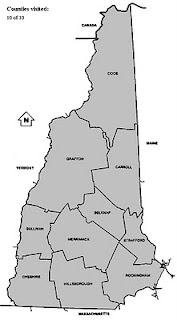Driving through New England the other day, I noticed one of those freeway lanes set aside for "high-occupancy vehicles" -- cars with two people in them; motorcycles, buses. This freeway lane was at least 15 miles long, and included specially-built exit overpasses, so that its ecologically responsible users wouldn't have to work their way through the mass of ordinary folk in the other lanes. There was not a single vehicle using that lane in its entire length.
Now: the idea of these dedicated HOV lanes is to reward people who car pool, making their trips faster by getting them out of the gridlock and speeding them on their way. I can see some value in that; we want to encourage people to car-pool. And I would expect that there would be fewer cars in the HOV lanes than in the other lanes -- if there weren't, HOV lanes would be useless. But there were none. Absolutely none. And where I could see the HOV lanes heading the other direction, I saw not one single vehicle over there either.
There still has to be some kind of cost-benefit analysis given to the construction of these lanes. I find it hard to believe that any serious objective analysis was done. How much does it cost to build a mile of freeway a single lane wide? How much does it cost to build 15 miles of it? How much to build the special overpasses for dedicated use? How much to build the added shoulder and guard railings? How much for the carpool parking lots that are part of the system? (Probably not much for that last one, but something.) And how much does it cost each year to maintain all that added infrastructure?
And how much benefit do we get, from the added productivity of HOV users who arrive at work four minutes earlier, or stay later, or are more alert from a more relaxing commute? How much from the pollutants that were not emitted by the vehicles that weren't used? How much from the unspent fuel? (And note that the benefits from using motorcycles and buses are not properly a benefit of the HOV lane, except to the extent that the presumed faster transit on the HOV lane encourages motorcycle or bus ridership. Neither are the benefits of using hybrid or other low emission vehicles, which in some places are allowed to use HOV lanes with only one occupant.) (And, do these expensive-to-build, expensive-to-maintain roadways actually achieve their stated objectives? The one study I found says not.)
I know there are ways to quantify these things in dollars and cents. I would like to see the calculations, but I suspect either they weren't done, or weren't done properly, or were just ignored in the interest of politics. And I suspect something uglier than mere politics.
And how much benefit do we get, from the added productivity of HOV users who arrive at work four minutes earlier, or stay later, or are more alert from a more relaxing commute? How much from the pollutants that were not emitted by the vehicles that weren't used? How much from the unspent fuel? (And note that the benefits from using motorcycles and buses are not properly a benefit of the HOV lane, except to the extent that the presumed faster transit on the HOV lane encourages motorcycle or bus ridership. Neither are the benefits of using hybrid or other low emission vehicles, which in some places are allowed to use HOV lanes with only one occupant.) (And, do these expensive-to-build, expensive-to-maintain roadways actually achieve their stated objectives? The one study I found says not.)
I know there are ways to quantify these things in dollars and cents. I would like to see the calculations, but I suspect either they weren't done, or weren't done properly, or were just ignored in the interest of politics. And I suspect something uglier than mere politics.
I've seen these HOV lanes all over the country, and in Canada. In some places, mostly in the very largest sprawling cities, like Houston and Phoenix, they seem to get enough use to justify the cost. I say "seem" because, again, I don't have any quantitative basis for analysis. There are others, as in Tampa and Minneapolis/St. Paul, that are toll lanes ("HOT lanes"), sometimes with no charge to high-occupancy traffic, reducing (or, theoretically (though I bet it hasn't happened since the old Dallas-Fort Worth Turnpike was paid off) eliminating) the cost to the public. But if you take it that frequently-used HOV lanes are worth their cost to society, while underused HOV lanes are not, then I would say from what I've seen around the country that HOV lanes are too often a waste of money.
In a representative democracy, we elect public officials to oversee the answering of such questions. We all know these representatives are subject to all of the failings of ordinary mortals, but still we expect them to husband public resources the way they would their own. We expect them to use due care in deciding what project is a good investment, and what project is not.
Sometimes they will get it wrong in the analysis. Sometimes the information provided to them will be incorrect, or incomplete. Sometimes it will be lies and sometimes they won't catch those lies. Sometimes they will be influenced by the desires of the loudmouth segments of their constituencies: the special-interest groups, the lobbyists, the organized groups of citizens who care a great deal about issues that most of us think only modestly important. Sometimes they will be influenced by corrupt influences, generally either money, power, or sex. Sometimes they will just exercise poor judgment, and sometimes they will just be stupid. They are, after all, ordinary mortals themselves, and in theory their failings will be dealt with at the next election.


%20rue%20Suger.jpg)
.jpg)







.jpg)


.JPG)
